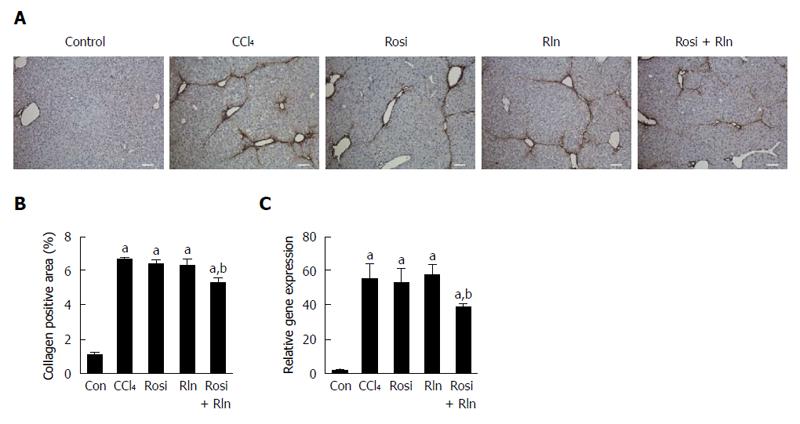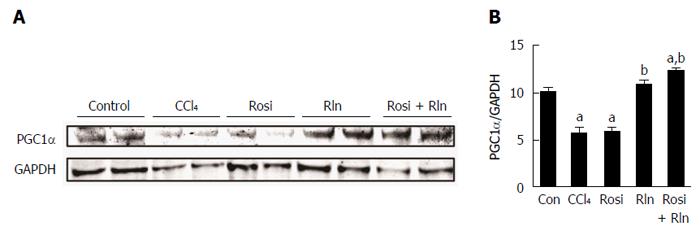Copyright
©The Author(s) 2017.
World J Gastroenterol. Jun 14, 2017; 23(22): 3999-4006
Published online Jun 14, 2017. doi: 10.3748/wjg.v23.i22.3999
Published online Jun 14, 2017. doi: 10.3748/wjg.v23.i22.3999
Figure 1 Total liver collagen content.
A: Sirius red staining of liver tissue from control (Con), fibrotic (CCl4), rosiglitazone (Rosi), serelaxin (Rln) or combination-treated (Rosi + Rln) mice. Bar: 100 μm. B: Sirius red staining quantified. Data are expressed as mean ± SE, and analyzed by ANOVA (n = 5). aP < 0.001 vs Con; bP < 0.05 vs CCl4, Rosi, or Rln.
Figure 2 Liver type I collagen content.
A: Immunohistochemical staining of liver tissue from control (Con), fibrotic (CCl4), rosiglitazone (Rosi), serelaxin (Rln) or combination-treated (Rosi + Rln) mice. Bar: 100 μm; B: Type I collagen staining quantified; C: Type I collagen gene expression determined by qPCR. Data are expressed as mean ± SE, and analyzed by ANOVA (n = 5). aP < 0.05 vs Con; bP < 0.05 vs CCl4, Rosi, or Rln.
Figure 3 Liver smooth muscle actin content.
A: Immunohistochemistry of liver tissue for SMA content from control (Con), fibrotic (CCl4), rosiglitazone (Rosi), serelaxin (Rln) or combination-treated (Rosi+Rln) mice. Bar: 100 μm; B: SMA staining quantified. Data are expressed as mean ± SE, and analyzed by ANOVA (n = 5). aP < 0.001 vs Con; bP < 0.05 vs CCl4; cP < 0.05 vs CCl4, Rosi, or Rln.
Figure 4 Western blotting of PGC1α content in livers from control (Con), fibrotic (CCl4), rosiglitazone (Rosi), serelaxin (Rln) or combination-treated (Rosi + Rln) mice.
A: Liver tissue extracts were analyzed by Western blotting for PGC1α. The levels of GAPDH are shown as a loading control; B: The levels of PGC1α relative to GAPDH were determined by densitometry. Data are shown as mean Data are expressed as mean ± SE, and analyzed by ANOVA (n = 5). aP < 0.05 vs Con; bP < 0.01 vs CCl4 or Rosi.
- Citation: Bennett RG, Simpson RL, Hamel FG. Serelaxin increases the antifibrotic action of rosiglitazone in a model of hepatic fibrosis. World J Gastroenterol 2017; 23(22): 3999-4006
- URL: https://www.wjgnet.com/1007-9327/full/v23/i22/3999.htm
- DOI: https://dx.doi.org/10.3748/wjg.v23.i22.3999












